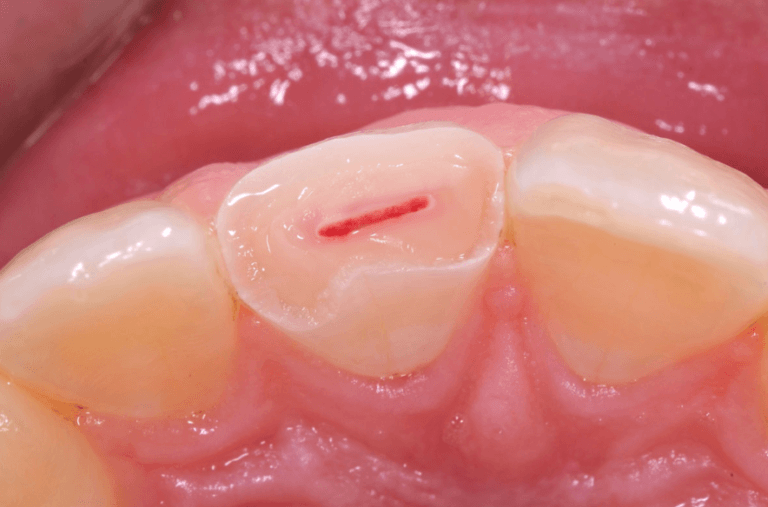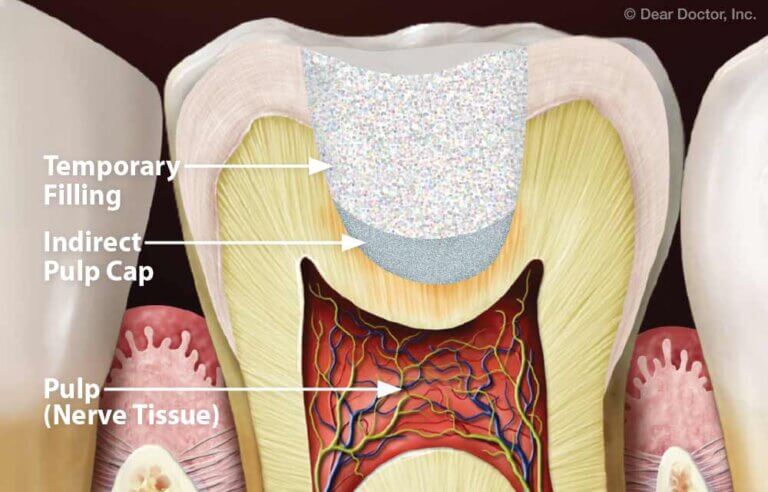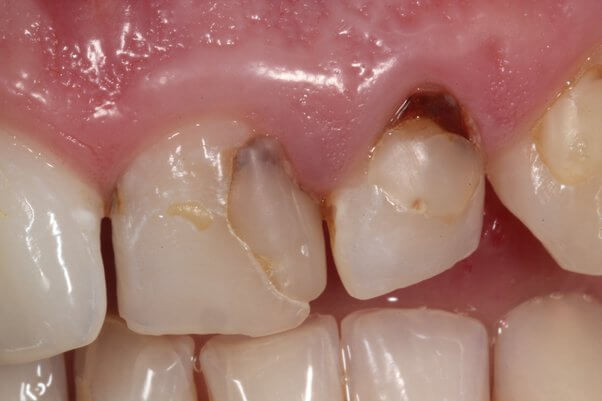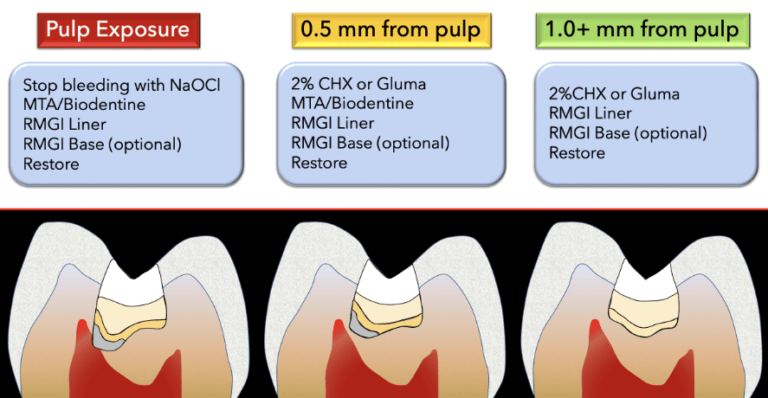Indirect Pulp Capping

What Is Indirect Pulp Capping?
Indirect Pulp Capping is a dental procedure designed to protect the dental pulp — the soft, innermost part of your tooth containing nerves, blood vessels, and connective tissues — when it’s at risk of infection due to decay or trauma. Unlike root canal treatment, which removes the pulp entirely, Indirect Pulp Capping aims to shield the pulp without removing it. This minimally invasive treatment helps preserve the natural structure of the tooth, often preventing the need for more extensive dental work.
Before deciding on whether Indirect Pulp Capping are right for you, there are some things you should know:
- Who Needs Indirect Pulp Capping?
- Benefits of Indirect Pulp Capping
- Alternatives to Indirect Pulp Capping
- How Much Does Indirect Pulp Capping Cost?
- Steps In The Indirect Pulp Capping Procedure
- Frequently Asked Questions About Indirect Pulp Capping
If you have any further questions about Indirect Pulp Capping or other dental services offered at Atlas Dental, please contact us.

Free phone consultation
Have questions about Dental Pulp Capping? Schedule a free phone consultation with our Toronto dentist.

5 star google reviews
Our patients love us! See for yourself why more and more people are choosing Atlas Dental for Dental Pulp Capping.

Book Emergency tooth filling
Do you think you have cavities and need a Dental Pulp Cap? Book an emergency tooth filling online.
Who Needs Indirect Pulp Capping?
Patients with the following conditions may benefit from Indirect pulp capping:
- Early-Stage Decay: Patients with minor dental decay that hasn’t yet reached the pulp are ideal candidates.
- Deep Fillings: If a filling is very close to the pulp, Indirect Pulp Capping can protect it from irritation.
- Trauma or Injury: For teeth that have sustained minor fractures or trauma but still have a healthy pulp.
- Sensitive or Symptomatic Teeth: In cases where symptoms like pain or sensitivity occur without obvious decay or pulp damage.
- Preventive Measure: Dentists may recommend this for large fillings where the pulp remains healthy.
Your dentist will consider the specific circumstances of your dental issue and determine whether this procedure is suitable for your case. If you have further questions about Indirect Pulp Capping, please contact us.

Benefits of Indirect Pulp Capping
Indirect Pulp Capping is beneficial for both patients and dentists due to its minimally invasive nature and effectiveness in saving teeth. Here are some key advantages:
- Preserves Natural Teeth: Keeps the original tooth intact without extensive procedures like root canals or extractions.
- Minimally Invasive: Involves less removal of tooth structure, making recovery quicker and more comfortable.
- Cost-Effective: Generally, Indirect Pulp Capping is less expensive than more invasive procedures like root canals.
- Pain Relief: Helps reduce sensitivity and discomfort caused by early decay or trauma.
- Reduces Treatment Time: Typically requires fewer visits and less time in the dental chair.
It’s important to remember that the suitability of Indirect Pulp Capping depends on the specific circumstances of your dental issue and should be determined by a qualified dentist. If you have further questions about Indirect Pulp Capping, please contact us.
Alternatives to Indirect Pulp Capping
If you and your dentist decide that Indirect Pulp Capping is not the most suitable option for your dental condition, there are alternative treatments available to address your specific needs:
- Direct Pulp Capping: Applied when there is a larger pulp exposure, this technique can also encourage healing.
- Root Canal Therapy: If the pulp is already infected, a root canal may be the best option for saving the tooth.
- Tooth Extraction: In severe cases, extraction may be necessary, with options for replacement like dental implants or bridges.
Your dentist will discuss these options and help you decide on the best treatment for your situation. If you have further questions about Indirect Pulp Capping, please contact us.

Cost of Dental Pulp Capping
The cost of Dental Pulp Capping, whether it is done using a direct or indirect technique, is the same as the cost of a dental filling.
Routine Dental Fillings cost $207-477 depending on the location of the tooth (anterior, bicuspid or molar), as well as the number of “surfaces” involved. Imagine each tooth as a 5 surface box. Each “surface” of this imaginary box will dictate the size (and cost) of the tooth filling. The codes relevant to regular dental fillings in the Ontario Dental Association’s Suggested Fee Guide appear as follows:
Permanent Anteriors:
- 23111 – One surface: $205
- 23112 – Two surfaces: $256
- 23113 – Three surfaces: $308
- 23114 – Four surfaces: $379
- 23115 – Five surfaces (maximum surfaces per tooth): $400
Permanent Bicuspids:
- 23311 – One surface: $226
- 23312 – Two surfaces: $283
- 23313 – Three surfaces: $339
- 23314 – Four surfaces: $414
- 23315 – Five surfaces or maximum surfaces per tooth: $435
Permanent Molars:
- 23321 – One surface: $246
- 23322 – Two surfaces: $308
- 23323 – Three surfaces: $369
- 23324 – Four surfaces: $451
- 23325 – Five surfaces or maximum surfaces per tooth: $477
Regular Dental Fillings are considered a basic service under all dental insurance plans and should be covered to your maximum insurable limit, but be sure to find out from your dental insurance plan provider how much you are eligible for before going ahead with dental treatment. Our fees are consistent with the ODA Fee Guide.
For patients without dental insurance, Atlas Dental is pleased to offer dental financing through iFinance Dentalcard. Affordable payment plans start at 7.95% for terms of 6 months to 6 years. To learn more about Dentalcard dental treatment financing, follow this link.
Steps In The Indirect Pulp Capping Procedure
The procedure involves specific steps to ensure the dental pulp’s health and prevent further complications. Here’s an overview of the typical steps involved in Indirect Pulp Capping:
- Examination and X-rays: Your dentist will examine the affected tooth and take X-rays for a detailed assessment.
- Local Anesthesia: A local anesthetic numbs the area to ensure comfort during the procedure.
- Decay Removal: The decayed portion of the tooth is carefully removed.
- Application of Protective Material: A biocompatible substance is placed above the pulp to stimulate healing.
- Sealing the Tooth: A filling or crown is applied to protect the area and restore tooth function.
- Follow-Up: Post-procedure care instructions will be given, including guidelines on oral hygiene and dietary restrictions.
While it’s generally a safe and effective treatment, success depends on various factors, including early detection, appropriate patient selection, and proper post-procedure care. If you have further questions about Indirect Pulp Capping, please contact us.

Frequently Asked Questions About Indirect Pulp Capping
Can I Have Indirect Pulp Capping During Pregnancy?
Yes, with precautions. Generally, it’s best to schedule elective dental treatments during the second trimester. Always inform your dentist about your pregnancy, and consult with your obstetrician.
Is Indirect Pulp Capping Safe?
Yes, this procedure is safe and effective when performed by an experienced dentist. It’s minimally invasive and preserves natural tooth structure.
How Long Does the Procedure Take?
The procedure is relatively quick, usually taking about 30–60 minutes, depending on the tooth’s condition.
What Is the Success Rate of Indirect Pulp Capping?
With proper patient selection and care, Indirect Pulp Capping has a high success rate. Following your dentist’s aftercare instructions is key to long-term success.
Success rates for this procedure are generally high, especially when used in appropriate cases by a skilled dentist. If you have further questions about Indirect Pulp Capping, please contact us.

